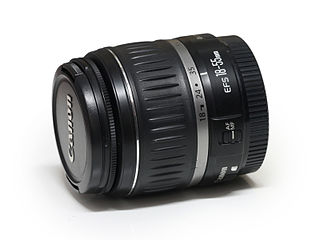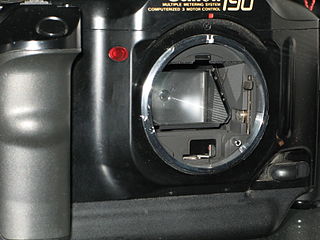| Maker | Canon |
|---|---|
| Technical data | |
| Focus drive | Utrasonic motor |
| Focal length | 28–90 mm |
| Aperture (max/min) | f/4–f/32 |
| Close focus distance | 1.3ft / 0.38m |
| Max. magnification | 0.30 (at 90mm) |
| Diaphragm blades | 5 |
| Construction | 10 elements in 8 groups |
| Features | |
| Short back focus | |
| Lens-based stabilization | |
| Macro capable | |
| Physical | |
| Max. length | 2.8 in / 71mm |
| Diameter | 2.6 in / 67mm |
| Weight | 6.7 oz / 190 g |
| Filter diameter | 58mm |
| Accessories | |
| Lens hood | EW-60C |
| Angle of view | |
| Horizontal | 65°–22°40' |
| Vertical | 46°–15°10' |
| Diagonal | 75°–27° |
| Retail info | |
| MSRP | $189.99 USD |
The Canon EF 28–90 mm is a lens included as a kit lens with Canon EOS film cameras.
A kit lens is a "starter" lens which can be sold with an interchangeable-lens camera such as a single-lens reflex camera. It is generally an inexpensive lens priced at the lowest end of the manufacturer's range so as to not add much to a camera kit's price. The kit consists of the camera body, the lens, and various accessories usually necessary to get started in SLR photography. A kit lens can be sold by itself outside of a kit, particularly the ones that are moderately expensive; for instance a kit lens included in a prosumer SLR kit is often marketed as an upgrade lens for a consumer SLR. In addition, retailers often have promotions of standalone low-end SLR bodies without the lens, or a package that bundles the SLR body with one or two more expensive lenses.
Canon Inc. is a Japanese multinational corporation specializing in the manufacture of imaging and optical products, including cameras, camcorders, photocopiers, steppers, computer printers and medical equipment. It's headquartered in Ōta, Tokyo, Japan.

Canon EOS is an autofocus single-lens reflex camera (SLR) and mirrorless camera series produced by Canon Inc.. Introduced in 1987 with the Canon EOS 650, all EOS cameras used 35 mm film until October 1996 when the EOS IX was released using the new and short-lived APS film. In 2000, the D30 was announced, as the first digital SLR designed and produced entirely by Canon. Since 2005, all newly announced EOS cameras have used digital image sensors rather than film. The EOS line is still in production as Canon's current digital SLR (DSLR) range, and, with the 2012 introduction of the Canon EOS M, Canon's mirrorless interchangeable-lens camera (MILC) system.
The maximum aperture is f/4 at 28mm, reducing to f/5.6 at 90mm. When focused at 90mm this will create background blur for portrait photography.
It is a very lightweight design, and has very fast auto focusing even without USM. Image quality suffers particularly between 28–35mm and 80–90mm however, and there is heavy vignetting when used wide open.
For digital EOS cameras with APS-C sensors, the EF-S 18–55mm lens covers the same range. This is due to crop factor. EF-S lenses only work with Canon 1.6x crop cameras, which results in an angle of view roughly equivalent to that of a 29–90mm lens on a 35mm camera. Like the 28–90mm, the 18–55mm is also a kit lens. [1]

Advanced Photo System type-C (APS-C) is an image sensor format approximately equivalent in size to the Advanced Photo System film negative in its C ("Classic") format, of 25.1×16.7 mm, an aspect ratio of 3:2.

The Canon EF-S 18–55mm lens f/3.5–5.6 is a Canon-produced wide-angle to mid telephoto zoom lens for digital single-lens reflex cameras with an EF-S lens mount. The field of view has a 35 mm equivalent focal length of 28.8–88mm, and it is a standard kit lens on Canon's consumer APS-C DSLRs. In February 2017 Canon announced the new Canon EF-S 18–55mm lens f/4–5.6 IS STM with a smaller aperture, which made the lens 20% smaller according to Canon.

In digital photography, the crop factor, format factor or focal length multiplier of an image sensor format is the ratio of the dimensions of a camera's imaging area compared to a reference format; most often, this term is applied to digital cameras, relative to 35 mm film format as a reference. In the case of digital cameras, the imaging device would be a digital sensor. The most commonly used definition of crop factor is the ratio of a 35 mm frame's diagonal (43.3 mm) to the diagonal of the image sensor in question; that is, CF=diag35mm / diagsensor. Given the same 3:2 aspect ratio as 35mm's 36 mm × 24 mm area, this is equivalent to the ratio of heights or ratio of widths; the ratio of sensor areas is the square of the crop factor.












